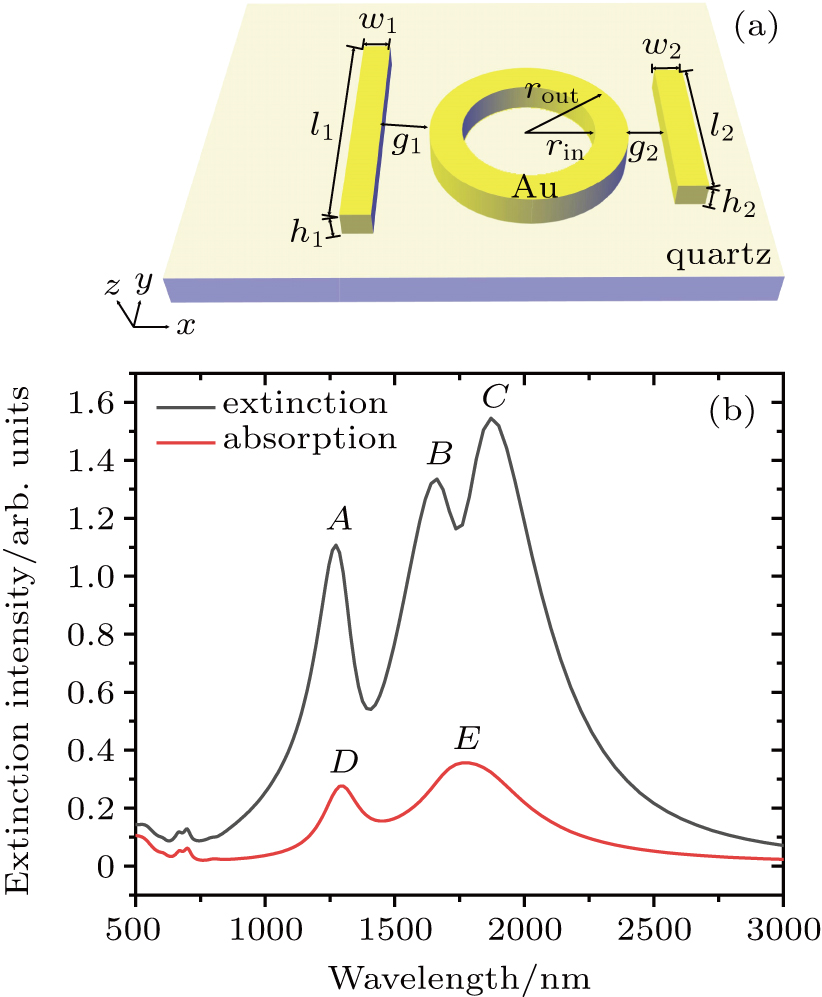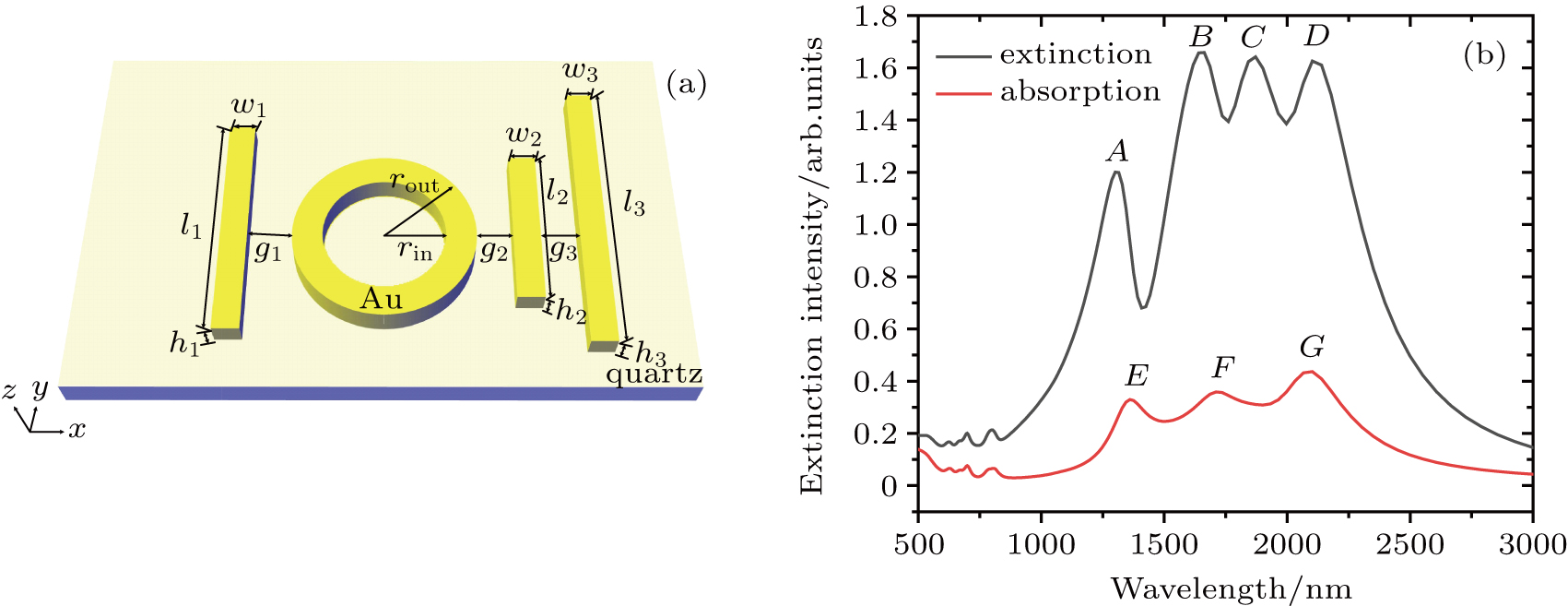† Corresponding author. E-mail:
Project supported by the National Natural Science Foundation of China (Grant Nos. 11674275, 11601469, and 61505174), the Natural Science Foundation of Hebei Province, China (Grant Nos. F2016203282, C2014203212, and E2016203185), and the Science and Technology Research Project of Hebei Higher Education Institutions, China (Grant No. QN2018071).
Multiple Fano resonances of plasmonic nanostructures have attracted much attention due to their potential applications in multicomponent biosensing. In this paper, we propose a series of hybridized nanostructures consisting of a single nanoring and multiple nanorods to generate multiple Fano resonances. One to three Fano resonances are achieved through tuning the number of nanorods. The interaction coupling process between different components of the nanostructures is recognized as the mechanism of multiple Fano resonances. We also theoretically investigate the applications of the produced multiple Fano resonances in refractive index sensing. The specific properties of multiple Fano resonances will make our proposed nanostructures beneficial to high-sensitivity biosensors.
Plasmonic resonances, the collective oscillation of free electrons, of metallic nanostructures have the ability to concentrate the incident light beyond the optical diffraction limitation and significantly enhance the intensity of the localized electromagnetic field, which enables plasmonic nanostructures to be applied in color printing, luminescence enhancement, optical security, and photovoltaic devices.[1–5] Therefore, optical properties of plasmonic nanostructures have attracted much attention. Specifically, nonlinear optical properties of plasmonic nanostructures, such as Fano resonance, electromagnetic induced transparency, and Rabi splitting, have been intensively investigated.[6–10] Among these nonlinear phenomena, Fano resonances have aroused great interest for their specific characteristics of narrow full width at half maximum, high quality factor, and sensitive response to the change of refractive index of the surrounding medium, and therefore find wide applications in nanoelectronics, displays, and biosensors.[11–14]
Fano resonance was firstly recognized as a specific phenomenon in the quantum domain.[15] However, more and more reports about Fano resonances and their applications have been demonstrated in the nanophotonic area with the development of nanofabrication technologies, including focused ion beam and electron beam lithography.[16–18] In nanophotonics, Fano resonances are produced by plasmonic couplings between neighboring nanoparticles. The coupling process will produce a superradiant bonding mode (nanoparticles oscillating in phase) and a subradiant antibonding mode (out of phase). The broad superradiant mode overlaps with the sharp subradiant mode and forms a Fano resonance.[19,20] Since Fano resonances have been introduced into the plasmonic area, different shapes of metallic nanostructures have been intensively proposed to generate Fano resonances, such as ‘XI’-shaped nanoclusters,[21] asymmetric nanodisks,[22] nanodisk oligomers,[23] nanoring oligomers,[24] and split ring resonators.[25] Recently, dielectric nanostructures made of silicon or TiO2 were also demonstrated to produce Fano resonances.[26,27]
In comparison to plasmonic nanostructures with single Fano resonance, nanostructures producing multiple Fano resonances are of interest due to their different responsibility to multiple components of the surrounding environments and potential applications in multicomponent biosensing.[28] Therefore, how to produce multiple Fano resonances is beneficial to biosensors for multicomponent analysis. Here, we propose a series of hybrid nanostructures consisting of a single nanoring and multiple nanorods to produce multiple Fano resonances. One to three Fano resonances are sequentially demonstrated with tuning the number of nanorods. A plasmonic hybridization model is employed to analyze the coupling mechanism of these Fano resonances. We also theoretically investigate the applications of our proposed multiple Fano resonances in refractive index sensors.
The proposed hybrid nanostructures that produce one/multiple Fano resonances are composed of a single nanoring and one/multiple nanorods. The schematic illustration of the hybrid nanostructure for one Fano resonance is shown in Fig.
 | Fig. 1. (a) Schematic of the NRD nanostructure consisting of one nanoring and one nanorod. (b) The extinction and absorption spectra of the NRD. |
We will discuss the mechanism of the multiple Fano resonances with simulation of the near-field electric field and charge density distributions with commercial finite-difference time-domain software. A plane wave with vertical polarization is utilized as incident light, and the wavelength range is selected as 500 nm to 3000 nm. Perfect matching layers are adopted as the boundary conditions, and the step sizes of calculations are 5 × 5 × 5 nm3. The substrate is quartz with a refractive index of 1.4, and the dielectric function for gold is extracted from Johnson and Christie’s data.[29]
Figure
In order to investigate the mechanism of the Fano resonance in the NRD, we separately simulate the extinction spectra of the nanorod and nanoring, as shown in Figs.
In the following parts, we increase the number of nanorods and make the nanoring sequentially couple with these nanorods to form multiple Fano resonances. First, we add an extra nanorod to the right side of the NRD nanostructure and the triple-nanoparticle cluster is termed as NRDD, as shown in Fig.
 | Fig. 3. (a) A unit cell of the NRDD nanostructure consisting of one nanoring and two nanorods. (b) The extinction and absorption spectra of the NRDD. |
To investigate the underlying physics of these two Fano resonances, we calculate the near-field electric field and charge density distributions of the corresponding peaks in Fig.
When we continually add an additional nanorod to the NRDD, a more complex plasmonic coupling process will be observed and more Fano resonances can be achieved.[36,37] As shown in Fig.
 | Fig. 5. (a) Schematic illustration of the NRDDD consisting of one nanoring and three nanorods. (b) The extinction and absorption spectra of the NRDDD. |
Figure
We also theoretically investigate the applications of the proposed two Fano resonance nanostructure (NRDD) in biosensing. Figure
In this paper, multiple Fano resonances of nanostructures consisting of one single nanoring and different numbers of nanorods and their underlying physics are theoretically investigated. With the help of a plasmonic hybridization model, we decompose the multiple Fano resonances of the proposed nanostructures into different coupling processes between different nanoparticle components. We also apply the proposed multiple Fano resonance in the refractive index-related biosensing. The presented nanostructures and their specific optical properties will be beneficial in plasmonic biosensing and multicomponent analyzing.
| [1] | |
| [2] | |
| [3] | |
| [4] | |
| [5] | |
| [6] | |
| [7] | |
| [8] | |
| [9] | |
| [10] | |
| [11] | |
| [12] | |
| [13] | |
| [14] | |
| [15] | |
| [16] | |
| [17] | |
| [18] | |
| [19] | |
| [20] | |
| [21] | |
| [22] | |
| [23] | |
| [24] | |
| [25] | |
| [26] | |
| [27] | |
| [28] | |
| [29] | |
| [30] | |
| [31] | |
| [32] | |
| [33] | |
| [34] | |
| [35] | |
| [36] | |
| [37] |





